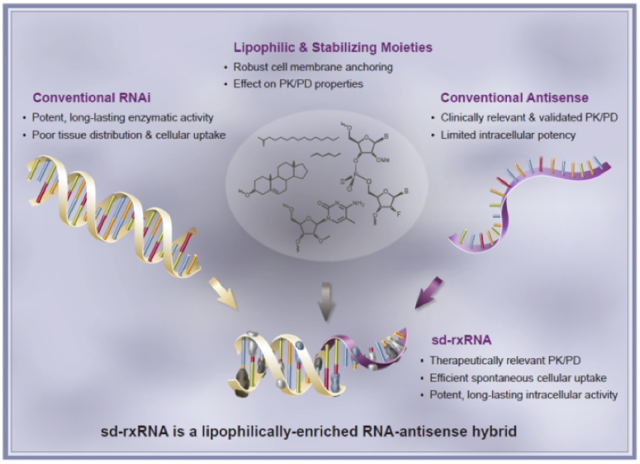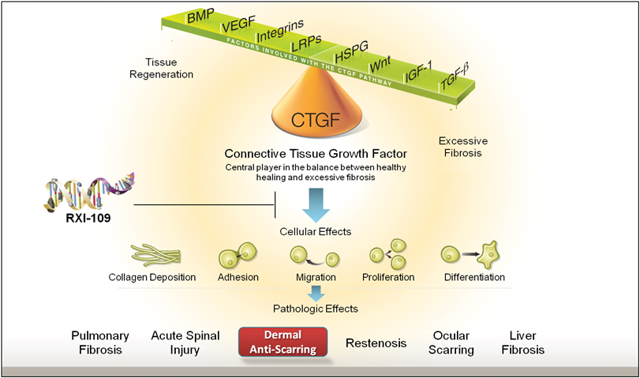TM editors’ note: This article discusses a penny stock and/or microcap. Such stocks are easily manipulated; do your own careful due diligence.
RXi pharmaceuticals (RXII) is a biotechnology company focused on developing unmet medical needs using RNAi therapeutics. RNAi stands for RNA interference which is a new science that was co-founded by Dr. Craig Mello and Dr. Andrew Fire. They both received the Nobel Prize for discovering RNAi, a mechanism of action where genes can be silenced from expressing a protein. Dr. Mello currently serves on the scientific advisory board for RXi Pharmaceuticals. With many catalysts coming in 2016 it should prove to be a good year for the company. This means that in 2016 and beyond, RXi shares are poised to trade higher on positive catalysts stemming from the company’s pipeline.
Sd-rxRNA Technology Platform Over Competitors
The biggest problem with RNAi failing to take off is that early companies were plagued with the problem of failed delivery attempts. Initially, companies tried to deliver small interfering RNA — siRNA — without any type of delivery vehicle. The problem was that there wasn’t any sufficient delivery vehicle for RNAi to make it to the cell that it needed to silence. As the years have gone by,many RNAi biotechs have formulated delivery vehicles for their respective RNAi drugs and here they are as follows:
All these biotechs and many others have one thing in common, they have some form of a delivery vehicle needed to deliver their RNAi drugs to effectively knockdown the genes of the targeted diseases. RXi on the other hand is unique and it doesn’t use a delivery vehicle at all. The name of its technological platform is sd-rxRNA or self delivering RNAi molecules.

Source: RXi Pharmaceuticals
Having the ability to send their RNAi drugs without a delivery vehicle isn’t RXi’s only advantage over other technologies in the same RNAi space.
There Are Two Other Advantages:
Having the sd-rxRNA technology platform being both RNAi and RNA means that it has a clear advantage because it takes the best parts of both sciences. This means that the disadvantages of RNAi and RNA are left out, forming a potent sd-rxRNA technology that is sufficiently strong in cellular uptake. Being soluble means being able to take the current nucleic RNAi form and change it to a cream/liquid form. This will help with RXi’s pipeline products like ones for corneal scarring, and cosmeceuticals which will be described in more detail below. The key here is that the technology can be changed on a molecular level depending on the targeted indication.
Hypertrophic Scars
Scars that are small are noticeable but not in the same league as other scars known as hypertrophic scars. Hypertrophic scars are an excess of scar tissue that develop at the site of an injury to the skin or surgery performed. These types of scars affect all ethnic origins, however, they are more prevalent in people that are darker in skin such as: African Americans, Hispanics, or Asians.

Source
The graphic above is just a glimpse of a small hypertrophic scar, because they most certainly can grow bigger depending upon the patient and incident in question.
The company incorporated its sd-rxRNA technology to allow delivery to any targeted choice without a delivery vehicle. RXi management chose scars as the first target for a couple of reasons that seem to make a lot of sense in the grand scheme of things:
Looking at RNAi science, it is quite new, and RXi chose to go after scarring because of Connective Tissue Growth Factor — CTGF. Being able to deliver RNAi molecules systemically into the liver and other organs requires additional clinical work. Even with this additional clinical work, there is no guarantee that the siRNA — small interfering RNA molecule — will always reach its intended target.
Thus, the reason why RXi chose the skin first is because the RNAi drug can be injected into the skin as a local access point. This improves the chances of clinical outcome, compared on attempting to target systemic organs. This is where reduced investor risk comes into play, because RXi management is playing it safe by targeting the outside skin first. The company is working on eventually targeting systemic targets, such as the liver, but it wants to make sure it gets local delivery right before it branches out to systemic targets.

RXi Pharmaceuticals
Being able to target CTGF means opening the doors to other great opportunities. Targeting the skin means being able to go after other tissues such as: in the eye, the lung, the liver, and other targets. As can be seen in the graphic above the company can develop RXI-109 against big markets such as Pulmonary Fibrosis, Liver Fibrosis, Ocular scarring, Acute Spinal Injury, and many others. These other targets can be worth billions of dollars in market opportunity.













Leave A Comment